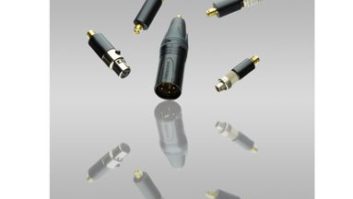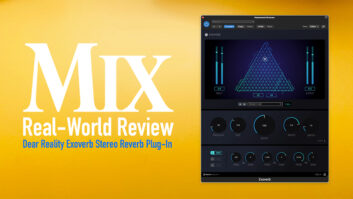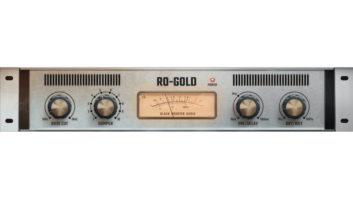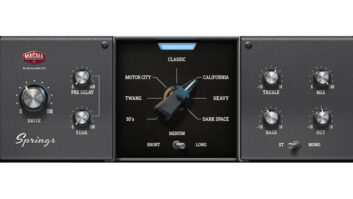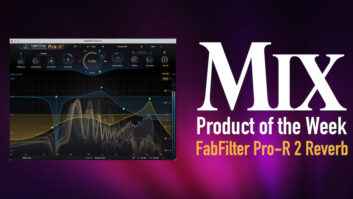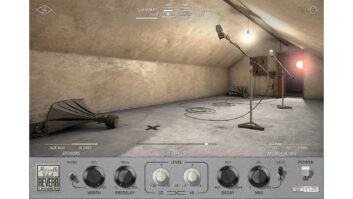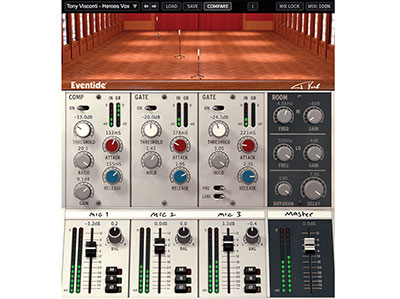
Eventide’s Tverb reverb plug-in starts with an emulation of the historic Meistersaal chamber music concert hall built in 1910 in Berlin and subsequently sold in 1976 to become Hansa-Tonstudio Studio 2, the choice for many pop stars including U2, Iggy Pop, Depeche Mode, David Byrne, Jon Bon Jovi and David Bowie. It was the unique reverberant characteristics of Hansa-Tonstudio Studio 2 that inspired record producer Tony Visconti to create the unique three-microphone lead vocal sound heard on David Bowie’s “Heroes,” recorded there in 1977. Using three independent reverbs, the Tverb reverb plug-in easily re-creates that sound and so many other unique reverbs.
Tverb launches in your DAW as either stereo in/stereo out, mono in/stereo out or mono in/out instance. Key is the big collection of the included professionally designed presets that make good starting setups for using Tverb as either an insert or send/return bus effect. The manual also has a “Tips And Tricks” section for unusual Eventide reverb soundscapes.
In the top third of the GUI window are three microphones named Mic 1, 2 and 3 shown in a virtual Studio 2 room. The reverberant sound quality of Tverb is governed by distance positioning, panning and processing of each of these mics.
Microphone 1 is in a fixed position in the front of the room and you can set its polar pickup pattern between omnidirectional, cardioid and figure-8. You can also switch in 8 kHz 12 dB/octave high cut and/or 150Hz 12 dB/octave low cut filters.
Microphones 2 and 3 are movable by clicking and dragging them around the virtual Studio 2 space. A small parameter text window shows their distances in feet and L/R lateral positioning, and you can type parameters directly into these windows—even place both mics in exactly the same spot in the room. Dragging the mics further out into the room adds pre-delay and changes the level of early reflections—just as would happen in a real room. For stereo reverbs, dragging side-to-side, left and right will increase more of that side’s stereo input signal.
More control over these microphones is accessed in the bottom two-thirds of the GUI with its effects, mixer and master sections. Looking like an old vintage mixing console with wood trim, gray metal panels, scribble strips and colored knobs, you can mix the level of each mic signal post reverb and any additional gate/compression processing. You can set stereo pan position (for stereo instances), solo/mute, flip polarity (Ø), and use the master fader to set the final mix level.
The mixer section has three dynamic modules, each one dedicated to a single microphone; they are not re-routable. Above and connected to Mic 1’s channel is a full-featured compressor for processing that signal as it is added into the reverb mix. When used as a send/return reverb, Mic 1 is the same signal as sent to Tverb from an aux send bus. If you use Tverb as an insert effect, Mic 1 acts as the Dry signal for Wet/Dry balance.
Next to the Mic 1 compressor are two gates—one each for Mics 2 and 3. They have on/off switches and familiar gate controls: Threshold, Attack, Release and Hold. The Pre button toggles the source for the gate’s key signal from either gate’s input signal (default) or from Mic 1’s signal post polar pattern choice but pre compressor processing.
A great feature that speeds setting up stereo gating is the Link switch that interconnects both gates’ parameters. Change a knob on one and the other gate’s knob changes right with it. Awesome, and of course you can unlink for individual parameter adjustment.
The Room Module changes the tone of the room itself. Not just an EQ, you can shape the room’s diffusion and size using the Diffusion and Decay time controls, plus tailor the room’s relative brightness/darkness with adjustable high/low frequencies and boost/cut controls.
Using Tverb
In homage to Tony Visconti’s “Heroes” mono vocal sound, I inserted a mono in/out instance of Tverb on an aux fader channel that received the lead vocal track sent to it on a bus. I started by just focusing on Mic 1’s sound and found it best to keep the vocal track at full-level to Tverb; any automated moves or equalization would be done on the aux fader—post Tverb on its output.
I used no roll-off filters on Mic 1 and set its polar pattern to omni, which “pulls in” more of the Meistersaal room sound—figure-8 pulls in less and cardioid is dry. I set Mic 1’s level to 0dB in the Tverb mixer and severely squashed it with the compressor! (Mic 1’s compressor is reminiscent of an old half-rack Pye 4060 limiter.)
Mic 2’s level became the main and constant (un-gated) mono reverb return for the vocal with the Room Module showing a 1.0 second Decay time and maximum Diffusion setting and appropriate filter settings. Mic 3 was a gated return of the same room that only faded and added more room whenever the vocal track sang louder. I used a 281ms attack time and a slow 1.2-second release time—these settings have to be adjusted so this effect operates smoothly, or not, if you want a more electronic effect.
Here is a variant of the manual’s Inverse Tverb effect. Place both mics exactly in the same position in the room by typing in identical distance and lateral positions. Flip the polarity of Mic 3 and make both Mic 2 and 3 the same level in the mixer and pan them to center. If you only gate Mic 3 so when it opens, it phase cancels the same reverb signal coming from Mic 2. To maintain complete cancellation while adjusting reverb level, shift clicking will raise/lower their levels together.
With Tverb set up on an acoustic guitar track, I duplicated the track and panned the pair left and right and slightly changed the Decay time on the left and right Tverb instances. Whenever the acoustic played softly, the gate threshold was not exceeded and stayed shutdown on Mic 3 and I got reverb from Mic 2’s channel only. Harder, louder playing caused the gate to open and cancel all reverb. Good trick that worked reliably.
Tverb’s Meistersaal room simulation is full of character, and being able to sculpt its intrinsic nature in specific ways greatly expands this plug-in’s usefulness. I imagine Visconti would have loved to be able to tinker with Tverb’s parameters back in the day. With many great starting presets and complete automation support for all parameters, Tverb is a unique reverb-based effect and is now part of my mix template in Pro Tools. It is a big winner from Eventide and it should be standard kit for any modern music maker/mixer!
TRY THIS
For an acoustic guitar track that combines soft playing with hard strumming, I started with the factory default preset and set up Tverb as a stereo send/return effect. Using a stereo send bus to Tverb, I put Mic 1 out of polarity with the Ø switch, set to omni, used no filters and set it to -15.9dB level and compressed it. With Mic 2 at 35 feet away and 30L and Mic 3 positioned 36 feet and 25R and gated using their own input signal, I was able to have a long reverb only come up when the acoustic played hard. But when quietly played, the acoustic dried up and became more present.
Product Summary
COMPANY: Eventide Inc.
PRODUCT: Tverb Reverb Plug-in Version 1
WEBSITE: www.eventideaudio.com
PRICE: $249; AU, VST and AAX for Mac and PC
PROS: Fantastic special effects reverb usable for everything.
CONS: Gate sections could use both range and ratio controls.

